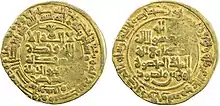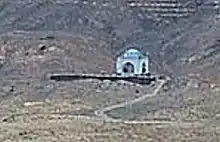| Sabuktigin سبکتگین | |||||
|---|---|---|---|---|---|
 | |||||
| Emir of Ghaznavid Empire | |||||
| Reign | 20 April 977 – August 997 | ||||
| Predecessor | Böritigin | ||||
| Successor | Ismail | ||||
| Born | c. 942 Barskhan (present-day Kyrgyzstan) | ||||
| Died | 5 August 997 (aged 55) Balkh, Greater Khorasan | ||||
| Spouse | Daughter of Alptigin | ||||
| Issue | Ismail Mahmud Abu'l-Muzaffar Nasr Yusuf Hurra-yi Kalji | ||||
| |||||
| Dynasty | House of Sabuktigin | ||||
| Father | Qara Bajkam[1] | ||||
| Religion | Sunni Islam (Hanafi) | ||||
Abu Mansur Nasir al-Din Sabuktigin (Persian: ابو منصور سبکتگین) (c. 942 – August 997), also spelled as Sabuktagin, Sabuktakin, Sebüktegin and Sebük Tigin, was the founder of the Ghaznavid dynasty, ruling from 367 A.H/977 A.D to 387 A.H/997 A.D.[2] In Turkic the name means beloved prince.[3]
Sabuktigin lived as a slave during his youth and later married the daughter of his master Alptigin, the man who seized the region of Ghazna (modern Ghazni Province in Afghanistan). Alptigin and Sabuktigin still recognized Samanid authority, and it was not until the reign of Sabuktigin's son Mahmud that the rulers of Ghazni became independent.[2][4]
When his father-in-law Alptigin died, Sabuktigin became the new ruler and expanded the kingdom after defeating Jayapala of Udabhandapura to cover the territory as far as the Neelum River in Kashmir and the Indus River in what is now Pakistan.[5]
Early years
Sabuktigin[lower-alpha 1] was born in or around 942 to the Turkic Barskhan tribe,[lower-alpha 2] in what is today Barskon, in Kyrgyzstan.[6][7] He was captured by the neighbouring Tukhsis in a tribal war and sold at the Samanid slave market at Chach.[8] He rose from the ranks of Samanid slave guards to come under the patronage of the Chief Hajib Alptigin.[8]
A merchant of the name of Nusr-Hajy having purchased Sabuktigin while yet a boy, brought him from the Turkic steppes to Bukhara, where he was sold to Aluptugeen, who, perceiving in him the promise of future greatness, raised him by degrees to posts of confidence and distinction, till, at length, on his establishing his independence at Ghazni, he conferred on him the title of amir al-umara (chief of the nobles), and also that of Vakil-i-Mutluk, or Representative.[9]
Alptigin later fled Bukhara after a failed coup, capturing Zabulistan and Ghazna south of the Hindu Kush in modern-day Afghanistan,[10] he raised Sabuktigin to the position of a general and gave his daughter in marriage to him. Sabuktigin served Alptigin, and his two successors Ishaq and Balkatigin.
Pirai, a slave of Alptigin, succeeded to throne of Ghazni in 972 A.D. His misrule led to resentment among the people, who invited Abu Ali Lawik, son of Abu Bakr Lawik, to invade Ghazni. The Kabul Shahis allied with him and the king, most likely Jayapala, sent his son to assist Lawik in the invasion. When the allied forces approached Charkh on the Logar River, they were attacked by Sabuktigin, who killed and captured many of them, whilst also capturing ten of their elephants. Piri was expelled from the governorship due to his acts and Sabuktigin became governor in 977 A.D. The accession was endorsed by the Samanid ruler Nuh II.[11]
Sabuktigin enlarged upon Alptigin's conquests, extending his domain from Ghazna to Balkh in the north, Helmand in the west, and the Indus River in what is today Pakistan.[9]
Sabuktigin was recognized by the Caliph in Baghdad as governor of his dominions. He died in 997 AD, and was succeeded by his younger son Ismail of Ghazni. Sabuktigin's older son, Mahmud, rebelled against his younger brother and took over Ghazna as the new emir.
Ferishta records Sebuktigin's genealogy as descended from the Sassanid emperors: "Sabuktigin, the son of Jukan, the son of Kuzil-Hukum, the son of Kuzil-Arslan, the son of Firuz, the son of Yezdijird, king of Persia."[9] Some doubt has been cast on this due to the lineage having been reckoned as too short to account for the 320 intervening years. What is known about Sebuktigin is that he was of Turkic origin. According to Grousset,
The Turkic mercenary army which Alptigin had raised in Ghazni, and which was already profoundly influenced by Islam, was from 977 onward led by another Turkic ex-slave -another Mameluke- named Sebuktigin, who made himself master of Tokharistan (Balkh-Kunduz) and Kandahar, and embarked upon the conquest of Kabul.[12]
Military career

Sabuktigin grew up in the court circles of Alptigin and was conferred the titles of Amīr al-umara (Chief of the Nobles), and Wakīl-e Mūtlak (Representative), ultimately being made general. He was then heavily involved in the defence of Ghazna's independence for the next 15 years, until Alptigin's death in 975.
Upon Alptigin's death, both Sabuktigin and Alptigin's son Abu Ishaq went to Bukhara to mend fences with the Samanids. Mansur I then officially conferred upon Abu Ishaq the governorship of Ghazna and acknowledged Sebuktegin as the heir. Abu Ishaq died soon after in 977 and Sabuktigin succeeded him in the governorship of Ghazna, subsequently marrying Alptigin's daughter.
In 977 AD he marched against Toghan, who had opposed his succession. Toghan fled to Bost, so Sebuktigin marched upon it and captured Kandahar and its surrounding area. This prompted the Shahi King Jayapala to launch an attack on Ghazna. Despite the fact that Jayapala amassed about 100,000 troops for the battle, Sebuktigin was soundly victorious.[13] The battle was fought at Laghman (near Kabul) and Jayapala was forced to pay a large tribute. He defaulted upon the payments, imprisoned Sebuktigin's collectors, and assembled a yet larger army consisting of 100,000 horse and an innumerable host foot, allied with forces from the kingdoms of Delhi, Ajmer, Kalinjar, and Kannauj, which was defeated in battle with Sebuktigin's Ghaznavids at the banks of the Neelum River in Kashmir.[9] Sebuktegin then annexed the regions of Afghanistan, Peshawar, and all the lands west of the Neelum River in Kashmir. According to Ferishta, "The Afghans and Khiljies who resided among the mountains having taken the oath of allegiance to Sabuktigin, many of them were enlisted in his army, after which he returned in triumph to Ghazni."[5]
In 994 he was involved in aiding Nuh II of the Samanids against internal uprisings and defeated the rebels at Balkh and then at Nishapur, thereby earning for himself the title of Nāsir ud-Dīn ("Hero of the Faith") and for his son Mahmud the title of Governor of Khorasan and Saif ud-Dawlah ("Sword of the State").[14]
Sabuktigin had increased Alptigin's domains to cover the area south of the Hindu Kush in Afghanistan and east to the Indus River in what is today Pakistan; he was eventually recognized by the Caliph in Baghdad as governor of his dominions.
Death and legacy

After becoming sick during one of his campaigns, Sabuktigin died in August 997 while travelling from Balkh to Ghazni in Afghanistan. The nature of his illness is unknown and the exact location of his death is uncertain. Minhaj al-Siraj Juzjani, a 13th-century historian, stated that "Sabuktigin died in the village of (Bermel Madwari, or Madar wa Moi, or Madawri, or Madraiwi, or Barmel Maderwi)." In modern times, Henry George Raverty has also mentioned Termez in his translations of the village name. Firishta, a 16th-century historian, has also mentioned Termez as the place of death of Subuktageen.[17] Abdul Hai Habibi believes that Sebuktigin's place of death is Marmal, Mazar-i-Sharif.[18] He was buried in a tomb in the village of Rawza, 4 kilometers to the northeast of Ghazni, which can be visited by tourists.[19] He was succeeded by his younger son, Ismail. Sabuktigin is generally regarded as the architect of the Ghaznavid Empire.
The conquests of Sabuktigin facilitated the beginning of the Turko-Afghan period into India, which would be further conducted by his son Mahmud of Ghazni, and later the Ghurids until the Turko-Afghans successfully established themselves in the Delhi Sultanate.[20][21]
Notes
- ↑ "The Turkish name Sebüktegin means “beloved prince,” but the second element (tegin “prince”) had declined in status from Orkhon Turkish times, becoming part of the onomastic of Turkish slave (ḡolām) commanders under the ʿAbbasids."
- ↑ It is possible the Barskhan tribe was part of the Qarluq Turks.[6]
References
- ↑ MERÇİL, ERDOĞAN (2009). "SEBÜK TEGİN". TDV Encyclopedia of Islam, Vol. 36 (Sakal – Sevm) (in Turkish). Istanbul: Turkiye Diyanet Foundation, Centre for Islamic Studies. ISBN 978-975-389-566-8.
- 1 2 C.E. Bosworth, "Ghaznavids" in Encyclopaedia Iranica. Date: December 15, 2001. Accessdate: July 4, 2012.
- ↑ The Turkish name Sebüktegin means “beloved prince,” but the second element (tegin “prince”) had declined in status from Orkhon Turkish times, becoming part of the onomastic of Turkish slave (ḡolām) commanders under the ʿAbbasids (Golden, pp. 52–53). "SEBÜKTEGIN" Encyclopædia Iranica. Retrieved 17 August 2014
- ↑ Frye 1975, pp. 165–166.
- 1 2 "AMEER NASIR-OOD-DEEN SUBOOKTUGEEN". Ferishta, History of the Rise of Mohammedan Power in India, Volume 1: Section 15. Packard Humanities Institute. Retrieved 31 December 2012.
- 1 2 Bosworth 1963, p. 39.
- ↑ Bosworth 2012.
- 1 2 Bosworth 1968, p. 6.
- 1 2 3 4 "AMEER NASIR-OOD-DEEN SUBOOKTUGEEN". Ferishta, History of the Rise of Mohammedan Power in India, Volume 1: Section 15. Packard Humanities Institute. Retrieved 30 December 2012.
- ↑ Bosworth 2006.
- ↑ Ramesh Chandra Majumdar (1966). The History and Culture of the Indian People: The struggle for empire. Bharatiya Vidya Bhavan. p. 3.
- ↑ Rene Grousset, The Empire of the Steppes, 1970, p.143, ISBN 0-8135-1304-9
- ↑ The History of India: The Hindu and Mahometan Periods, Elphinstone, pg 321
- ↑ The Ghaznavids, C.E. Bosworth, Age of Achievement: A.D. 750 to the End of the Fifteenth Century, Vol. 4, ed. M. S. Asimov, C. E. Bosworth, (UNESCO, 1998), 98.
- ↑ Massullo, Martina (2018). "EPIGRAPHIC SURVEY ON THE MAUSOLEUM OF MUḤAMMAD ŠARĪF ḪĀN AT GHAZNI (AFGHANISTAN)". Bulletin d'études orientales. 67: 161. ISSN 0253-1623. JSTOR 27076364.
- ↑ "غزنی، دیروز و امروز". BBC News (in Persian). 31 May 2011.
- ↑ Tareekh-e-Firishta, by Mohammad Qasim Firishta, written in 1611 CE, Accessed 2013 CE
- ↑ "Madr wa Moi". Abdul Hai Habibi. alamahabibi. Retrieved 17 August 2012.
- ↑ Massullo, Martina (2018). "EPIGRAPHIC SURVEY ON THE MAUSOLEUM OF MUḤAMMAD ŠARĪF ḪĀN AT GHAZNI (AFGHANISTAN)". Bulletin d'études orientales. 67: 161. ISSN 0253-1623. JSTOR 27076364.
- ↑ Mukerjee, Radhakamal (1958). A History of Indian Civilization: Ancient and classical traditions. Hind Kitabs. p. 73.
- ↑ Puri, B. N.; Das, M. N. (1 December 2003). A Comprehensive History of India: Comprehensive history of medieval India. Sterling Publishers Pvt. Ltd. p. 9. ISBN 978-81-207-2508-9.
Sources
- Bosworth, C.E. (1963). The Ghaznavids: Their Empire in Afghanistan and Eastern Iran, 994-1040. Edinburgh at the University Press.
- Bosworth, C.E. (1968). "The Political and Dynastic history of the Iranian World (A.D. 1000-1217)". In Boyle, J.A. (ed.). The Cambridge History of Iran. Vol. 5: The Saljuq and Mongol Periods. Cambridge at the University Press.
- Bosworth, C. E. (1975). "The Early Ghaznavids". In Frye, R. N. (ed.). The Cambridge History of Iran. Vol. 4: From the Arab Invasion to the Saljuqs. Cambridge: Cambridge University Press. pp. 162–198. ISBN 0-521-20093-8.
- Bosworth, C.E. (2006). "Ghaznavids". Encyclopaedia Iranica.
- Bosworth, C. Edmund (2012). "Sebüktegin". Encyclopædia Iranica.
- Frye, R. N. (1975). "The Sāmānids". In Frye, R.N. (ed.). The Cambridge History of Iran. Vol. 4: From the Arab Invasion to the Saljuqs. Cambridge University Press. pp. 136–161. ISBN 0-521-20093-8.
- Houtsma, M. Th (1987). E.J. Brill's First Encyclopaedia of Islam 1913–1936. Brill. pp. 1–299. ISBN 9789004082656.
| Preceded by: Böritigin |
Emir of Ghazna 977–997 |
Followed by: Ismail |